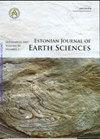奥陶系辐射时期深海殖民的技术特征
IF 0.8
4区 地球科学
Q4 GEOSCIENCES, MULTIDISCIPLINARY
引用次数: 0
摘要
与浅海环境相比,深海环境的化石记录是出了名的贫乏。值得注意的是,深海沉积物通常拥有多样化和丰富的痕迹化石组合,为古代深海底栖动物提供了证据。为了分析深海的早期殖民,我们从埃迪卡拉-泥盆纪地层单位的调查中构建了一个全球痕迹化石出现的数据集。这一分析强调了奥陶纪辐射作为深海殖民的关键时期的重要性。埃迪卡拉纪深海痕迹化石由非常简单的痕迹和洞穴组成。总体和α多样性以及技术差异极低。非专业放牧路径揭示了微生物席的开发。这些策略在寒武纪持续存在,尽管物种多样性(全球和α)和物种差异有所增加。在寒武纪期间,形态模式的复杂性明显增加,如地下采矿石属Oldhamia所示。在寒武纪末期和奥陶纪初期,随着农业和捕鲸策略的长期扩张,深海的面貌开始发生变化。早奥陶世在深海中形成了规则的网状、精细的螺旋状洞穴、引导蜿蜒的字形化石等主要建筑图案,标志着浅海岩鱼相的首次出现。下至中奥陶统的深海鱼动物群具有中等的多样性,通常以fodinichnia为主,而不是graphoglypides。晚奥陶世—早志留世的鱼类多样性和差异显著增加,石雕类的比例较高,证明了现代深海生态系统的建立。泥灰岩与古二叠统鱼亚相的区别也可以追溯到奥陶系的辐射,泥灰岩以泥质浊积岩中的摄食痕迹为主,而泥灰岩以砂质浊积岩中的绘形体为主。在整个志留纪和泥盆纪,这种向深海扩张的趋势一直持续着。然而,碳酸盐浊积岩的定植可能落后于硅屑浊积岩。字形生物的丰度和多样性的逐渐增加导致了画廊生物扩散器的作用增加。这种深海动物更替与斜坡和坡底环境中氧合作用的增加是一致的,这被认为是奥陶纪生物多样性的驱动因素。深海中永久开放洞穴的形成可能增加了深海沉积物最上层的生物灌溉,因此增加了通风,并可能在生物扰动和氧化作用之间产生反馈回路,而底栖生物则对其环境进行了改造。本文章由计算机程序翻译,如有差异,请以英文原文为准。
The ichnologic signature of deep-sea colonization during the Ordovician radiation
The fossil record of deep-marine environments is notoriously poor in comparison with that of their shallow-marine counterparts. Notably, deep-marine deposits are typically host to diverse and abundant trace-fossil assemblages, providing evidence of the ancient deep-sea benthos. To analyze the early colonization of the deep sea, we constructed a global dataset of trace-fossil occurrences from a survey of Ediacaran–Devonian stratigraphic units. This analysis highlights the importance of the Ordovician radiation as a pivotal time in the colonization of the deep sea. Ediacaran deep-marine trace fossils consist of very simple trails and burrows. Global and alpha ichnodiversity, as well as ichnodisparity, were extremely low. Nonspecialized grazing trails reveal the exploitation of microbial mats. These strategies persisted in the Cambrian, although with an increase in ichnodiversity (both global and alpha) and ichnodisparity. An increase in the complexity of morphologic patterns, as illustrated by the undermat mining ichnogenus Oldhamia , is apparent during the Cambrian. The face of the deep sea started to change during the end of the Cambrian and beginning of the Ordovician with the protracted expansion of farming and trapping strategies. The main architectural designs of deep-marine trace fossils (e.g. regular networks, delicate spiral burrows, guided meandering graphoglyptids) were established in the deep sea by the Early Ordovician, recording the first appearance of the Nereites Ichnofacies. Lower to Middle Ordovician deep-marine ichnofaunas are moderately diverse, and fodinichnia commonly dominates rather than graphoglyptids. A significant ichnodiversity and ichnodisparity increase occurred in the Late Ordovician–early Silurian, with ichnofaunas recording higher proportions of graphoglyptids and evidencing the establishment of a deep-marine ecosystem of modern aspect. The distinction between the Nereites and Paleodictyon ichnosubfacies, with the former characterized by the dominance of feeding traces in muddy turbidites and the later by the dominance of graphoglyptids in sandy turbidites, can also be tracked back to the Ordovician radiation. This trend of increased colonization of the deep sea continued through all the Silurian and the Devonian. However, colonization of carbonate turbidites may have lagged behind that of siliciclastic turbidites. The progressive increase in abundance and diversity of graphoglyptids resulted in an increased role of gallery biodiffusers. This faunal turnover in the deep sea was coincident with an increase in oxygenation in slope and base-of-slope settings, which is thought to have been a driver of Ordovician biodiversifications. The formation of permanent open bur-rows in the deep sea may have increased bioirrigation in the uppermost zone of the deep-sea sediment, therefore increasing ventilation and potentially generating a feedback loop between bioturbation and oxygenation, with the endobenthos engineering its environment.
求助全文
通过发布文献求助,成功后即可免费获取论文全文。
去求助
来源期刊

Estonian Journal of Earth Sciences
地学-地球科学综合
CiteScore
1.50
自引率
9.10%
发文量
11
审稿时长
>12 weeks
期刊介绍:
The Estonian Journal of Earth Sciences is an international scientific open access journal published by the Estonian Academy of Sciences in collaboration with the Tallinn University of Technology, the University of Tartu, the Estonian University of Life Sciences and the Talllinn University.
The journal publishes primary research and review papers in the English language. All articles are provided with short Estonian summaries.
All papers to be published in the journal are peer reviewed internationally.
The journal is open for publications in all fields of Earth sciences, including besides different geological sensu lato disciplines, also geography and oceanography having certain connection with our part of the world, North Europe and the Baltic area in particular.
 求助内容:
求助内容: 应助结果提醒方式:
应助结果提醒方式:


